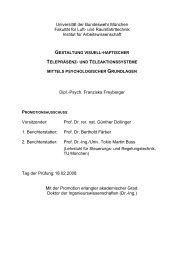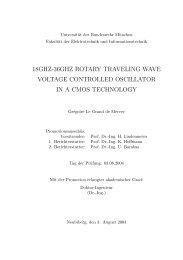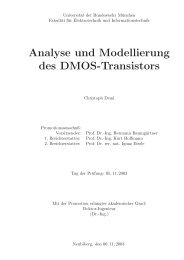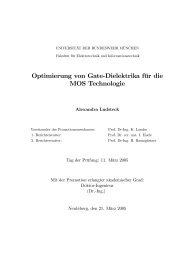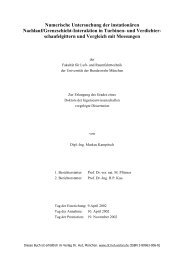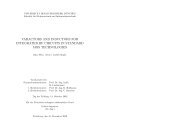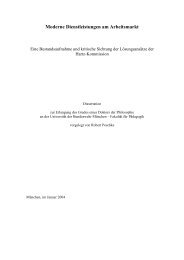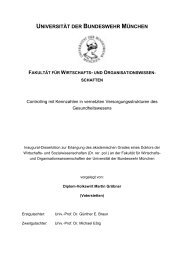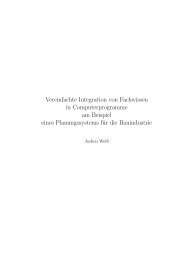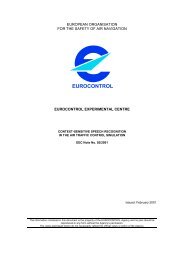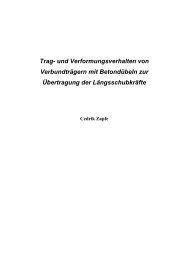Precise Orbit Determination of Global Navigation Satellite System of ...
Precise Orbit Determination of Global Navigation Satellite System of ...
Precise Orbit Determination of Global Navigation Satellite System of ...
You also want an ePaper? Increase the reach of your titles
YUMPU automatically turns print PDFs into web optimized ePapers that Google loves.
Chapter 5 Perturbation Models <strong>of</strong> IGSO,GEO and MEO <strong>Satellite</strong>s <strong>Orbit</strong>s<br />
5.2 The Solar and Lunar Attractions<br />
Due to the great distance between the Earth and the Sun and between the Earth and Moon, it is unnecessary to<br />
take the nospherical part <strong>of</strong> the Sun and Moon into account. For this reason, in the perturbation models the Sun<br />
and Moon are considered as point mass. The solar and lunar attractions on the satellite may be expressed in the<br />
inertial coordinate system as follows<br />
(Kovalevsky 1967, Beutler 1996)<br />
�<br />
=<br />
� �<br />
2 ϖ<br />
�<br />
ϖ ϖ ϖ<br />
d r µ ϖ<br />
r − �<br />
i r ri<br />
= − r + µ i � −<br />
2 3<br />
ϖ ϖ<br />
(5-23)<br />
3 3<br />
dt r i s,<br />
m ��<br />
| ri<br />
− r | ri<br />
�<br />
where<br />
ϖ<br />
r<br />
ϖ<br />
rs ϖ<br />
rm position vector <strong>of</strong> satellite<br />
position vector <strong>of</strong> Sun<br />
position vector <strong>of</strong> Moon<br />
µ , µ s, µ m gravity constants <strong>of</strong> the Earth, Sun and Moon respectively.<br />
In order to evaluate the influences <strong>of</strong> Sun and Moon on IGSO, GEO and MEO satellites, the accelerations<br />
produced by the solar and lunar attractions on IGSO and GEO satellites are computed using JPL Planetary<br />
Ephemeris DE200 and Eq.(5-23). The quantities <strong>of</strong> the accelerations and orbit errors by these two perturbation<br />
forces are listed in Table 5-6, Table 5-7 and Table 5-8 as well as are drawn in Figures 5-24, 5-25, 5-26 and 5-27.<br />
Table 5-6 The Effect <strong>of</strong> Solar and Lunar Attraction on IGSO <strong>Satellite</strong><br />
(<strong>Satellite</strong> Parameters: a=42164.174km, λ=20°, i=63°)<br />
Perturbation Force Acceleration <strong>Orbit</strong> Errors (m)<br />
(m/sec 2 ) One Day Ten Days<br />
Solar Attraction 3×10 -6 945 8915<br />
Lunar Attraction 6×10 -6 2590 77 (km)<br />
Table 5-7 The Effect <strong>of</strong> Solar and Lunar Attraction on GEO <strong>Satellite</strong><br />
(<strong>Satellite</strong> Parameters: a=42164.174km, λ=20°, i=0°)<br />
Perturbation Force Acceleration <strong>Orbit</strong> Errors (m)<br />
(m/sec 2 ) One Day Ten Days<br />
Solar Attraction 3×10 -6 2263 23183<br />
Lunar Attraction 6×10 -6 2311 14 (km)<br />
Table 5-8 The Effect <strong>of</strong> Solar and Lunar Attraction on MEO (GPS) <strong>Satellite</strong>*<br />
Perturbation Force Acceleration <strong>Orbit</strong> Errors (m)<br />
(m/sec 2 ) One Day Ten Days<br />
Solar Attraction 2×10 -6 800 3500<br />
Lunar Attraction 5×10 -6 3000 8000<br />
*Feltens, 1991; Landau, 1988<br />
56



